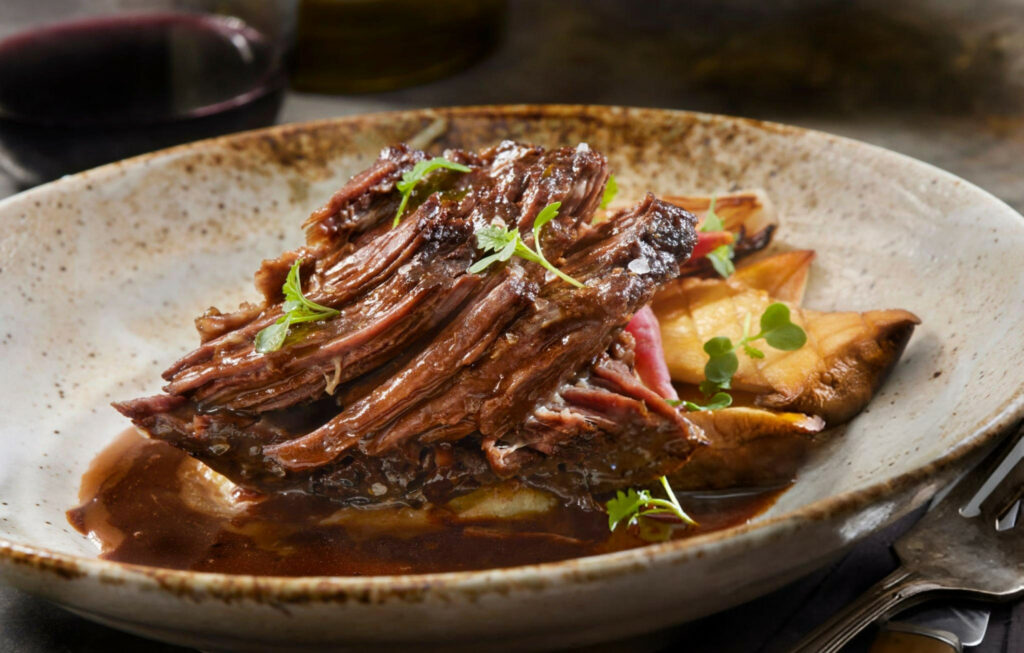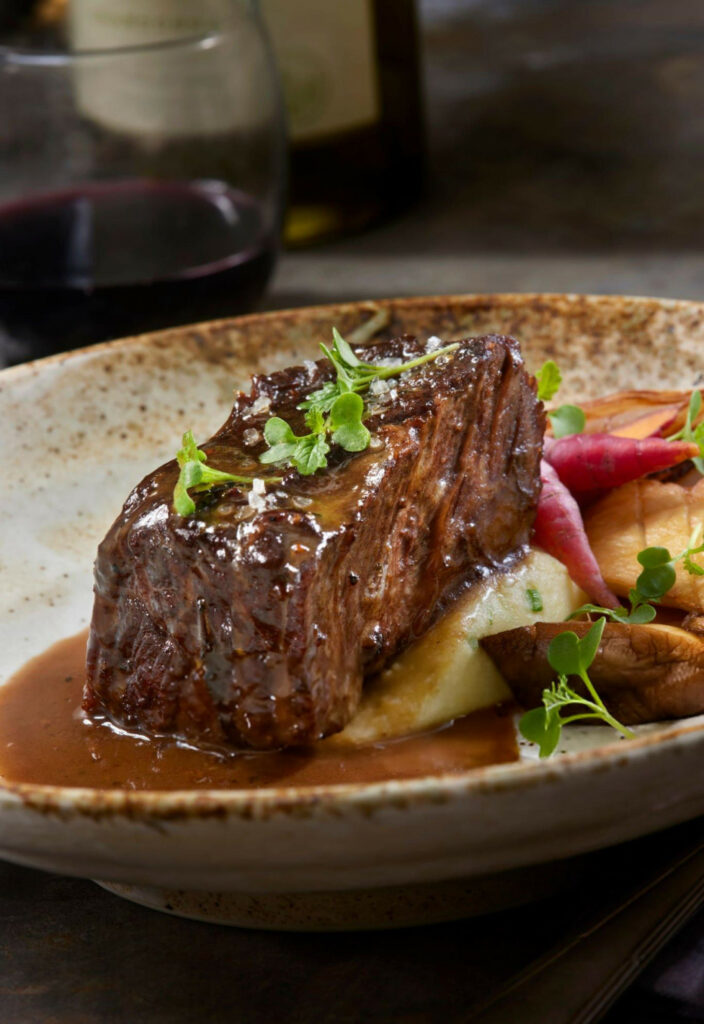Red wine braised boneless short ribs are the kind of dish that promises warmth, depth, and rich satisfaction with every bite. Tender cuts of beef simmer slowly in a savory wine reduction infused with herbs and aromatics, making this dish a sophisticated centerpiece for a cozy night in or a polished dinner with guests.

Ingredient Breakdown
Boneless short ribs are ideal for braising thanks to their marbling and structure. They soak up flavor beautifully and transform into succulent, fork-tender bites during the slow cook. Before braising, it’s best to pat them dry and season generously to build the flavor from the first sear.
Aromatics like diced onion and carrot provide a base of sweetness and depth. Tomato paste adds richness, while flour helps develop a slightly thickened sauce. These elements form the backbone of a deeply flavored braise.
The liquid foundation is a duet of dry red wine and broth. Wine provides acidity and bold character, while broth softens and rounds out the flavor. Together, they create a complex and hearty base for the meat to braise in.
Fresh herbs—parsley, thyme, and rosemary—plus a single bay leaf, create a bouquet garni that releases a woodland aroma and delicate earthiness into the sauce. Whether using fresh or dried, herbs must be balanced to avoid overpowering the dish.
Mini potatoes and thick-cut carrots are not just fillers—they absorb the braising juices, becoming soft and flavorful. Their addition near the end ensures they’re cooked perfectly without disintegrating.
Step-by-Step Braising Process
Browning the short ribs is an essential first step. A good sear locks in juices and creates a layer of fond at the bottom of the pot that adds tremendous umami to the sauce.
Once the meat is set aside, deglazing begins. Onion and carrot are sautéed, then tomato paste and flour are stirred in to form a savory paste. The red wine is poured in to lift all the caramelized bits, and reducing it by half concentrates the flavor.
After the reduction, broth and herbs join the mix. The meat returns to the pot, and the entire dish enters the oven to braise low and slow. The gentle heat breaks down connective tissue in the beef, rendering it tender.
Midway through, potatoes and carrots are added. This timing is key: it ensures the vegetables are tender but still hold their form, giving texture to every serving.
Once cooked, the dish is removed from the oven. Herbs are discarded, and the sauce is left to rest so the fat rises. Skimming off this fat results in a velvety, refined sauce. A gentle reheat binds everything back together for serving.

Recipe Tips
Use a Dutch oven for even heat and moisture retention
Don’t rush the wine reduction—this step concentrates the flavor
Skim fat from the sauce after resting for a cleaner finish
If liquid is low, add a mix of wine and broth before returning to the oven
Let the meat rest in the sauce for better flavor absorption before serving
What to Serve With This Recipe
A luscious bed of mashed potatoes or a spoonful of soft polenta works beautifully to catch every drop of the red wine sauce. The silkiness of the starch plays well against the hearty beef.
On the side, bright and crunchy greens like garlic-sautéed green beans or peas lend freshness and contrast. For something more rustic, serve with oven-roasted Brussels sprouts or broccolini.
Don’t forget the bread. A good crusty sourdough or warm dinner roll is perfect for sopping up the remaining sauce.
To drink, a bold red wine such as a Cabernet Sauvignon, Syrah, or Merlot enhances the braising notes and complements the depth of the dish.
Creative Variations
Try using bone-in short ribs for a richer finish, though you may need to adjust cooking time slightly.
Switching to beef broth instead of chicken creates a more robust flavor.
To give it a French-inspired twist, toss in pearl onions and cremini mushrooms during the final hour.
A final splash of aged balsamic vinegar can add a glossy tang to brighten the sauce just before serving.
Frequently Asked Questions
Can I make this dish a day in advance? Yes, and it often tastes better the next day.
What’s the best wine to use for braising short ribs? A dry red wine like Cabernet, Syrah, or Merlot works well.
Can I use bone-in short ribs instead of boneless? Absolutely, just extend the cook time slightly.
How do I store and reheat leftovers? Store in an airtight container and reheat gently over low heat.
What if I don’t have a Dutch oven? Use any heavy oven-safe pot with a tight-fitting lid.
Slow-cooked to tender perfection, this red wine braised short rib recipe combines luxurious depth with rustic comfort. It’s hearty, aromatic, and perfect for those who want a meal that feels both homey and refined—a modern classic for dinner tables worth remembering.

Ingredients
2 lb boneless short ribs (about 4 pieces)
1 tablespoon olive oil
1 medium onion, diced
1 medium carrot, peeled and finely diced
1 tablespoon all-purpose flour
1 tablespoon tomato paste
1½ cups dry red wine (*see notes)
1½ cups chicken broth or beef broth
5 sprigs flat-leaf parsley (or 2 teaspoons dried parsley)
4 sprigs fresh thyme (or ½ teaspoon dried thyme)
1 sprig fresh rosemary (or ½ teaspoon dried rosemary)
1 bay leaf
Salt and freshly ground black pepper
Vegetables:
8–10 mini potatoes, halved
1 large carrot, peeled, halved, and cut into 2-inch pieces
Instructions
Preheat the oven to 350°F (175°C).
Heat the olive oil in a Dutch oven or an oven-safe pot with a lid over medium-high heat. Once the oil is hot, sear the boneless short ribs until they’re deeply browned on all sides. Transfer them to a plate and set aside.
Reduce the oil in the pot, leaving just a thin layer. Add the diced carrots and onions and sauté over medium heat, stirring often, until the onions turn translucent and begin to soften—about 5 minutes.
Stir in the flour and tomato paste, mixing thoroughly to form a thick base. Let it cook for 1 minute, stirring constantly to prevent scorching.
Pour in the red wine and bring the mixture to a gentle boil. Reduce the heat to medium-low and let the wine simmer until it reduces by half—this should take around 20 to 25 minutes. Take your time with this step to build deep, concentrated flavor.
Once reduced, stir in the broth along with the parsley, thyme, rosemary, and bay leaf. Return the seared short ribs to the pot, nestling them into the liquid. Cover with the lid and place the pot in the preheated oven.
Let the short ribs braise for 1 hour and 15 minutes. Afterward, carefully remove the pot from the oven and add the halved potatoes and carrot pieces. If the braising liquid looks low, add a splash more broth or wine to ensure the vegetables cook properly. Cover and return the pot to the oven for another 1 hour and 15 minutes, or until the meat is fork-tender and the vegetables are soft.
Once done, take the pot out of the oven. Discard all herb sprigs and the bay leaf. Taste the braising liquid and adjust with salt and pepper as needed.
Transfer the short ribs and vegetables to a platter. Allow the sauce to sit undisturbed for 10 to 15 minutes so the fat can rise to the surface. Skim off the excess fat with a spoon.
Return the ribs and vegetables to the pot and warm gently over the stove before serving. Serve hot, spooning the rich, glossy sauce over the top.

Red Wine Braised Boneless Short Rib Recipe
Ingredients
- 2 lb boneless short ribs about 4 pieces
- 1 tablespoon olive oil
- 1 medium onion diced
- 1 medium carrot peeled and finely diced
- 1 tablespoon all-purpose flour
- 1 tablespoon tomato paste
- 1½ cups dry red wine *see notes
- 1½ cups chicken broth or beef broth
- 5 sprigs flat-leaf parsley or 2 teaspoons dried parsley
- 4 sprigs fresh thyme or ½ teaspoon dried thyme
- 1 sprig fresh rosemary or ½ teaspoon dried rosemary
- 1 bay leaf
- Salt and freshly ground black pepper
Vegetables:
- 8 –10 mini potatoes halved
- 1 large carrot peeled, halved, and cut into 2-inch pieces
Instructions
- Preheat the oven to 350°F (175°C).
- Heat the olive oil in a Dutch oven or an oven-safe pot with a lid over medium-high heat. Once the oil is hot, sear the boneless short ribs until they’re deeply browned on all sides. Transfer them to a plate and set aside.
- Reduce the oil in the pot, leaving just a thin layer. Add the diced carrots and onions and sauté over medium heat, stirring often, until the onions turn translucent and begin to soften—about 5 minutes.
- Stir in the flour and tomato paste, mixing thoroughly to form a thick base. Let it cook for 1 minute, stirring constantly to prevent scorching.
- Pour in the red wine and bring the mixture to a gentle boil. Reduce the heat to medium-low and let the wine simmer until it reduces by half—this should take around 20 to 25 minutes. Take your time with this step to build deep, concentrated flavor.
- Once reduced, stir in the broth along with the parsley, thyme, rosemary, and bay leaf. Return the seared short ribs to the pot, nestling them into the liquid. Cover with the lid and place the pot in the preheated oven.
- Let the short ribs braise for 1 hour and 15 minutes. Afterward, carefully remove the pot from the oven and add the halved potatoes and carrot pieces. If the braising liquid looks low, add a splash more broth or wine to ensure the vegetables cook properly. Cover and return the pot to the oven for another 1 hour and 15 minutes, or until the meat is fork-tender and the vegetables are soft.
- Once done, take the pot out of the oven. Discard all herb sprigs and the bay leaf. Taste the braising liquid and adjust with salt and pepper as needed.
- Transfer the short ribs and vegetables to a platter. Allow the sauce to sit undisturbed for 10 to 15 minutes so the fat can rise to the surface. Skim off the excess fat with a spoon.
- Return the ribs and vegetables to the pot and warm gently over the stove before serving. Serve hot, spooning the rich, glossy sauce over the top.


















